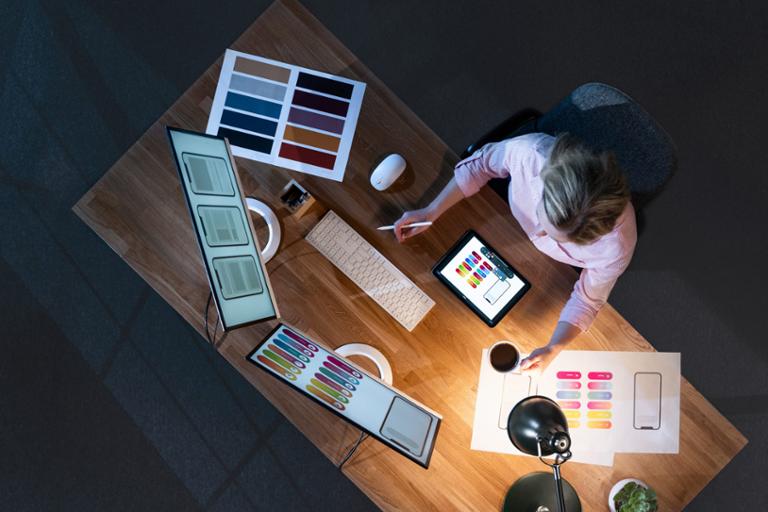Graphic designers serve a vital role in any organization. Their work draws customers in; it also conveys an organization’s brand and mission to the world. The best graphic designers have mastered a host of skills and tools, from “soft skills” like teamwork to design platforms like Adobe Creative Suite.
Specializing in graphic design offers multiple career paths, some of which come with notably high compensation—but how do you become a graphic designer in the first place?
Jess Rosenberg is director of brand design at Webflow, where she leads the brand studio team of visual and web designers, copywriters, project managers, video creatives, social media managers. “I was lucky enough very early on to know that I wanted to be a graphic designer,” she explains.
She joined a portfolio program at her high school that prepared her for pursuing a design career. Then she attended Carnegie Mellon University in Pittsburgh and graduated with a degree in graphic design.
“In that first year, we were introduced to both communication design concepts as well as industrial design concepts—layout, typography, grid color theory and putting all of those elements together, as well as design histories or learning about all of the greats that came before,” Rosenberg says.
Mastering Design Tools such as Adobe Creative Suite, Figma
After more than two decades in graphic design, Rosenberg has learned many tools as they've evolved over the years—with her standard go-to suite of tools found in Adobe Creative Suite. “That has been a consistent toolset in my arsenal for the past few decades, from Illustrator and Photoshop to even InDesign,” she says.
Over the past five years or so, she's delved into design tools like Figma. “Today that's the tool that my team predominantly works in for both digital and non-digital alike,” she says. “Figma is the tool of choice among many designers and design teams today. I would say it's a combination between Adobe Creative Suite and Figma.”
Rosenberg points out the rise of mobile technology means today's graphic designers need to be aware of how different screen sizes affect the way they design. “A mobile device is really just another format that designers should be thinking of, especially if you're designing for web,” she explains. “When designing for web, you consider various formats like desktop, tablet and mobile.”
That means it's important to keep responsiveness in mind. “By responsiveness, I mean like when you drag the browser from desktop down to tablet down to mobile size, all of your design needs to responsively flow to fit those breakpoints,” she notes.
Also keep in mind that hiring managers and recruiters will inevitably test you on all of these skills during the graphic designer job interview process. Make sure you come to any interview prepared to answer questions about your previous work, how you collaborated with teams, and how you overcame challenges. You’ll also likely need to walk your interviewers through your portfolio, so double-check it always contains your best and latest work. (Your graphic designer resume must be up-to-date, too.)
Mastering Your Soft Skills (and Your Audience)
Rosenberg explains there's a lot of pre-work that needs to be done before anyone should even start designing or putting pen to paper. If you’re interested in becoming a graphic designer, keep in mind that this pre-work is critical; you can’t just start designing and expect the results to meet your clients’ and team members’ needs.
This pre-work includes writing a creative brief and truly understanding the problem that you're trying to solve for, what audiences care about, and what makes them tick. “I think there's a lot that wasn't taught in design school, at least when I was there around focusing on strategy and problem-solving and understanding the audiences for which you are designing,” she says. “Having a thorough understanding of the 360-degree challenge you're trying to solve for will really help solve any problem once you start actually designing.”
Another key skill is the ability to hone your storytelling prowess, she adds. “This is about how you're presenting designs to stakeholders, to an executive team, potentially even your peers—it's super-important,” she says. “The way you communicate and collaborate among teammates is very important, as well. These days, being a designer, especially in-house, is a team sport, and being able to successfully collaborate in a values-led way is very important.”
Multiple Career Paths for Today's Graphic Designers
Rosenberg says today there are many different career paths that graphic designers should learn while they’re still in school.
“Some of the roles include a brand designer, which in the tech world is someone who has a genuine passion for design and creative culture,” she says. “They produce designs across a variety of formats, mediums, and environments. These include logos, visual identities, brand systems and marketing campaigns.”
Then there is the path of a UX designer, someone who designs the information architecture and user flow for a website or product. “That's another common path for someone who maybe not as visually inclined or likes creating the visual richness of an experience,” she explains. “Someone might be more interested in information systems and that might be a better path for them.”
Product designer is another common path for those with a graphic design background, which means designing the visual information architecture and interface for technology and software products. (It’s also one of those design jobs that can translate into high salaries and other compensation—just look at what product designer roles pay at Meta and other tech giants.)
“The product design team here at Webflow will do visual work on the design of the actual software in the product,” she says. “You can be a design systems designer where you're designing the actual systems and components of the actual product, making it a lot more fluid and agile for the product designers to then design the product.”
From Rosenberg's perspective, there are so many different paths these days. “There's also new roles, which are found on my team, too. It's called a visual developer, and that role is essentially a designer that is building in Webflow,” she says. “They're essentially replacing the old way of coding websites within Webflow, and it allows the team to get sites up and running fast and it allows us to be flexible and agile and we don't ever have to sacrifice design or output quality.”
Graphic Design Career Advice: Reach Out, Lean In
Rosenberg says there's tremendous value in meeting people who are already into their careers as graphic designers. “It's amazing how if you reach out to someone on LinkedIn, especially in today's climate, where folks are feeling friendly and open to connecting and helping others,” she says. “Just trying to make connections, learning from existing professionals, is really important.”
She points to a resource called ADPList, a design mentorship program, where she meets with aspiring designers weekly and coaches them on how to set up their portfolio, what they should do when looking for design jobs, and how to stand out from the crowd.
“I would encourage aspiring designers to network, as scary as that might be,” she adds. “I was definitely scared of doing that when I was younger, but trying just to meet as many people and learning from them, and not being afraid to lean in and take risks and reach out to people and introduce yourself.”
She thinks the folks reaching out to her are the ones who show the hunger and drive to be successful and make an impact. “I'm inclined to respond to them because that's the type of hunger and drive I look for in other people, especially when growing the team,” she says. “It's important for aspiring designers to have that drive to meet people who are passionate and super-excited about their craft and what they do.”
It's a competitive advantage if you have that drive. “I would say to my younger self, if I could, and others, to lean in as much as you can and try not to listen to that imposter syndrome, especially when there's so much competition out in the world,” Rosenberg says.
Related Graphic Designer Jobs Resources:
Graphic Designer Interview Questions



